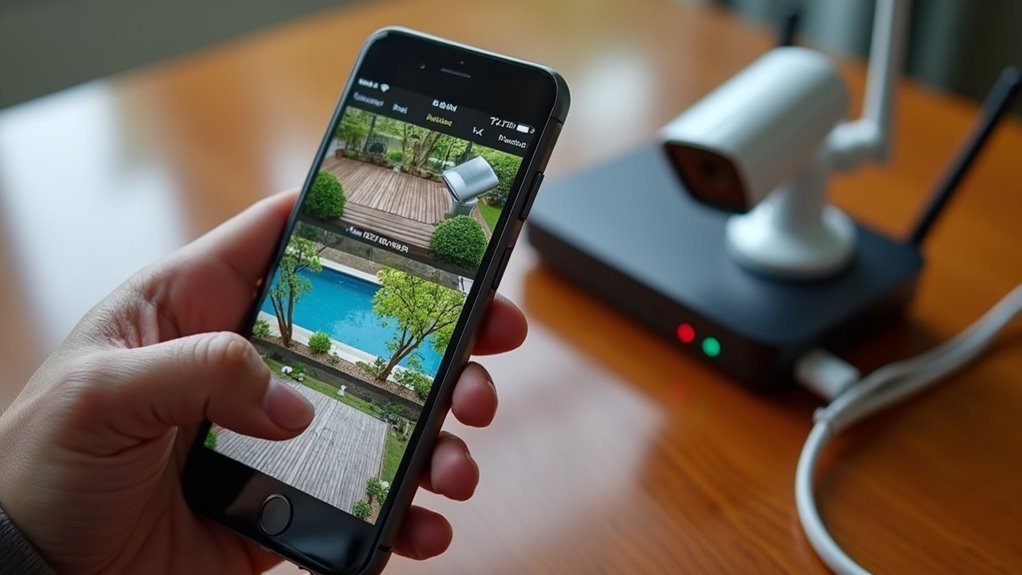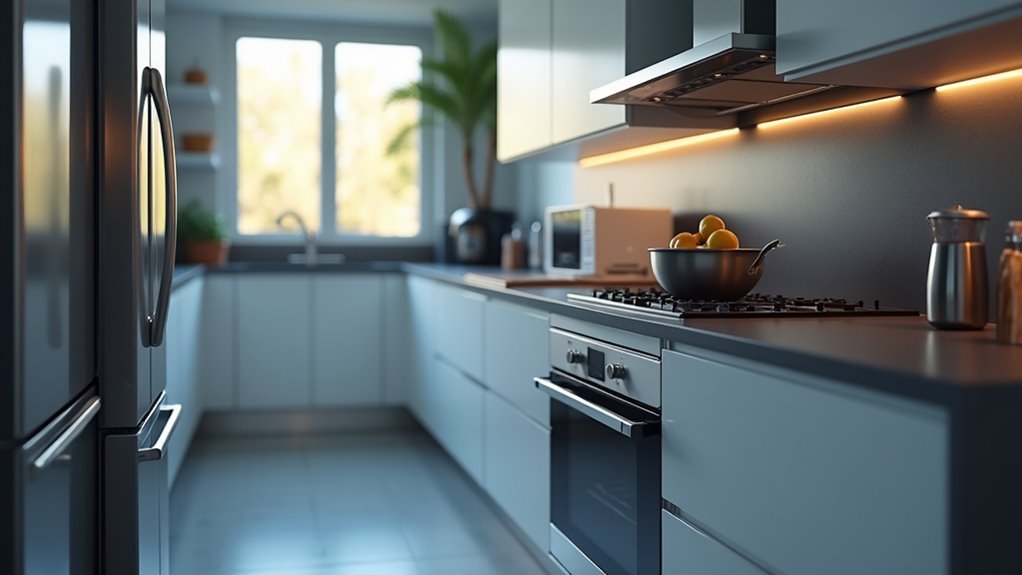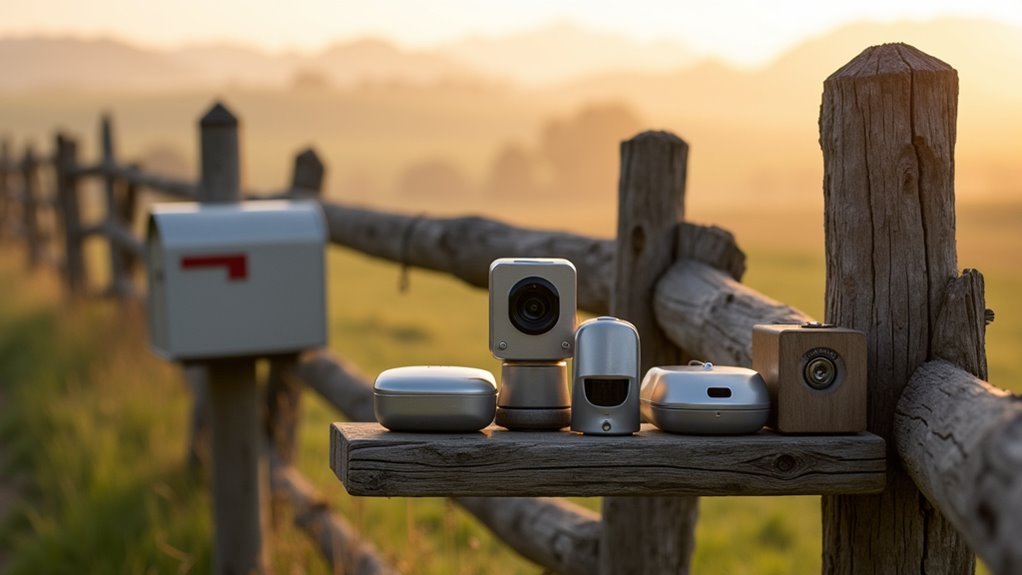You’ve probably struggled with juggling multiple apps just to control your smart lights, thermostat, and security system. Managing devices from different manufacturers shouldn’t require switching between five different interfaces throughout your day. The right cross-device dashboard can transform this chaotic experience into seamless control from a single platform. However, choosing the wrong tool means you’ll end up more frustrated than when you started with separate apps.
Amazon Alexa – Best Overall Smart Home Dashboard

When managing multiple smart devices across your home, Amazon Alexa stands out as the most extensive dashboard solution available.
You’ll appreciate its accurate voice controls and sophisticated interface that seamlessly integrates with countless smart devices. The platform’s Matter protocol support guarantees broader compatibility, letting you connect various brands into one cohesive smart home ecosystem.
Alexa’s Matter protocol support ensures seamless integration across multiple smart device brands within a single, unified ecosystem.
You can control everything through simple voice commands, making hands-free operation incredibly convenient for daily tasks.
The Echo Studio serves as the recommended hub, delivering enhanced audio quality while functioning as your central control point for multiple devices.
With regular updates continuously improving functionality and support, Amazon Alexa maintains its position as the leading smart home management solution you can rely on.
SmartThings – Most Compatible Cross-Platform Solution
Samsung’s SmartThings delivers unmatched compatibility as a cross-platform solution, supporting hundreds of brands and thousands of devices to create the most versatile smart home ecosystem you can build.
You’ll appreciate its easy-to-use interface that simplifies setting up automated routines across all your smart devices, regardless of manufacturer.
The platform’s accessibility shines through its preinstallation on Samsung Galaxy phones and availability for iPhone and Google Pixel users.
You can control your entire system hands-free using Google Assistant voice commands for seamless smart home control.
With the recommended Aeotec Smart Home Hub, SmartThings becomes your central command center, efficiently managing multiple brands under one compatible platform.
This thorough approach makes SmartThings ideal when you want maximum device flexibility without sacrificing functionality.
IFTTT – Advanced Automation Without Hubs

You’ll find IFTTT’s hub-free approach refreshes your smart home automation by connecting devices and services directly through the cloud without requiring additional hardware.
You can create powerful automation routines called “applets” using either thousands of prebuilt options or crafting custom ones through their intuitive web interface.
The platform’s simple trigger-action logic lets you build complex automation scenarios that respond to device changes, weather conditions, or time-based events across different brands and ecosystems.
Hub-Free Automation Setup
While traditional smart home setups often require expensive hubs to connect different devices, IFTTT (If This Then That) breaks down these barriers by enabling direct communication between your smart gadgets and online services.
This hub-free approach eliminates compatibility headaches and reduces costs while maximizing your automation potential.
You can choose from thousands of prebuilt applets or create custom automations using IFTTT’s intuitive interface—no coding skills required. The platform connects virtually any smart devices and services, from lights and thermostats to social media and weather apps.
Set triggers based on time, device status, or specific events to create sophisticated automations. While the free version limits you to two active applets, the Pro+ plan releases unlimited possibilities for extensive home automation.
Applet Creation Process
Creating IFTTT applets starts with understanding the simple but powerful trigger-action formula that drives every automation.
You’ll define your trigger (“If This”) by selecting from connected services like smart lights, weather updates, or location changes. Then specify your action (“Then That”) to automate tasks across different platforms.
The applet creation process becomes straightforward with thousands of prebuilt applets you can customize instantly.
Simply browse categories, select relevant automations, and modify parameters to match your preferences.
Advanced users benefit from Pro+ features that disclose sophisticated capabilities.
You’ll access conditional logic for complex decision trees and multiple triggers within single applets.
While free accounts limit you to two applets, the $5 monthly Pro+ subscription removes restrictions and enables unlimited automation scenarios.
Google Home – Optimal for Nest Device Integration
When you’re invested in Google’s ecosystem, Google Home stands out as the premier dashboard for managing your smart home devices. The app’s user-friendly interface makes controlling Nest devices effortless, whether you’re adjusting thermostats or monitoring doorbell cameras.
You’ll appreciate the robust automation features that let you create coordinated routines, controlling multiple devices simultaneously with single commands.
The 2023 redesign enhanced Matter protocol integration, expanding compatibility beyond Google’s hardware ecosystem. You can monitor your home’s security through smart camera features, switching between grid view and individual camera perspectives.
Front-door alerts keep you informed about arrivals, while household routines guarantee your devices work together seamlessly. For Nest device owners, Google Home delivers unmatched integration and control capabilities.
Home Assistant – Open-Source Hub-Free Platform

Home Assistant offers tech-savvy users complete control over their smart home ecosystem without vendor lock-in or monthly fees. This hub-free platform runs on various operating systems, including Linux and Raspberry Pi, making installation straightforward and cost-effective.
You’ll appreciate its extensive device compatibility across different brands and protocols, eliminating the need for multiple hubs.
The platform’s automation capabilities shine through its intuitive Rule Engine, allowing you to create complex scenarios with nested conditions. User privacy remains paramount since everything operates on your local network—no cloud processing required.
You can fully customize the user interface to match your preferences and needs. Home Assistant’s open-source nature means you’re not dependent on any single company’s continued support or changing business models.
Personalized Dashboard Builders With Drag-And-Drop Features
Whether you’re managing a few smart bulbs or orchestrating an entire connected ecosystem, personalized dashboard builders with drag-and-drop functionality transform how you interact with your smart home. These intuitive tools let you create custom smart home interfaces without technical expertise, arranging tiles and widgets exactly where you want them.
You’ll gain real-time control over all your connected devices from one centralized location. The drag-and-drop features make customization effortless—simply pull weather updates, device controls, and media feeds into your preferred layout.
| Feature | Benefit |
|---|---|
| Multi-platform compatibility | Works with various hubs and devices |
| Real-time monitoring | Instant status updates from anywhere |
| Custom tile integration | Weather, news, calendar, and media widgets |
| Intuitive editor | Create dashboards in minutes |
Rule Engine Tools for Simplified Automation Creation
Smart home automation becomes truly powerful once you discover rule engine tools that transform complex programming into simple visual workflows.
These user-friendly platforms feature drag-and-drop editors that make automation accessible regardless of your technical expertise. You can create sophisticated rules with nested conditions to handle complex scenarios across all your smart home devices.
The real strength lies in flexible triggers that respond to device status changes, time schedules, or environmental factors. This extensive customization guarantees your automation matches your specific lifestyle needs.
Whether you’re coordinating lighting with security systems or creating elaborate morning routines, rule engines provide the backbone for seamless smart home management.
Continuous exploration reveals advanced capabilities that make your connected home increasingly responsive and intelligent.
Multi-Hub Support Platforms for Device Integration
While rule engines provide the logical foundation for automation, multi-hub support platforms serve as the universal translators that bring together your diverse smart home ecosystem.
These platforms enable seamless device integration across different brands, letting you manage everything through a single interface. Popular solutions like SmartThings and Home Assistant offer multi-hub support, ensuring compatibility with thousands of devices from various manufacturers.
Multi-hub platforms eliminate compatibility barriers, unifying diverse smart home devices under one centralized management interface for streamlined control.
You’ll benefit from enhanced interoperability through the Matter protocol, which simplifies connections between different ecosystems.
These platforms let you create customized dashboards for real-time monitoring and control of your entire smart home. The advanced automation capabilities allow you to establish sophisticated rules and routines that span your complete connected environment, maximizing your smart home’s potential.
Browser-Based Dashboard Solutions for Universal Access
As smart home ecosystems expand beyond single platforms, browser-based dashboard solutions emerge as the perfect answer for universal device access.
You’ll find these tools work seamlessly across Android, iOS, Windows, Mac, and Fire Tablets through any modern browser, eliminating platform limitations.
Your browser-based dashboard transforms into a customized interface using drag-and-drop tiles, letting you arrange smart home devices exactly how you prefer.
Here’s what makes these solutions essential:
- Real-time monitoring of all connected devices whether you’re home or away
- Multiple hubs support including SmartThings, Hubitat, Home Assistant, and Homey
- Integrated feeds combining weather, calendars, and news for thorough control
You’ll appreciate having complete smart home management without downloading separate apps or worrying about device compatibility issues.
Security-Enhanced Dashboards With Guest Sharing Options
You’ll want security-enhanced dashboards that let you share access without compromising your main account’s safety.
These platforms offer PIN protection features that create temporary access codes for guests, keeping your primary credentials secure.
You can also set up granular guest access controls to determine exactly which devices and functions visitors can use during their stay.
PIN Protection Features
When unauthorized access threatens your smart home’s security, PIN protection features serve as your first line of defense against unwanted intrusions. These user-defined codes guarantee only authorized individuals can access your dashboard, protecting sensitive information from security cameras and device controls.
You’ll appreciate how these features work seamlessly with guest sharing options:
- Customizable access codes – Set different PINs for family members and guests, tailoring access levels to individual needs.
- Remote monitoring capabilities – Oversee who’s accessing your system at any time for complete peace of mind.
- Temporary guest access – Grant controlled dashboard access without compromising your smart homes’ overall security.
This integration creates a collaborative environment where you maintain complete control over privacy and device management while enabling others to use essential smart home features safely.
Guest Access Controls
Building on PIN protection, guest access controls let you extend dashboard functionality to visitors without sacrificing your home’s security perimeter.
You’ll find these security-enhanced dashboards offer temporary permissions that allow guests to control specific devices while protecting your personal settings and data. User-friendly interfaces make setup straightforward—you can quickly customize which devices guests can access and set time limits for their permissions.
Most smart home platforms now include guest sharing features that work seamlessly across multiple hubs and devices.
You can monitor guest activity in real-time, seeing exactly which controls they’re using and when. This secure access approach guarantees your entire system remains protected while giving visitors the convenience they need to adjust lighting, temperature, or entertainment systems during their stay.
Frequently Asked Questions
Is There an App to Control All Smart Home Devices?
Yes, you can use apps like Amazon Alexa, Google Home, or SmartThings to control all your smart devices. They’ll integrate different brands through Matter protocol, letting you manage everything from one centralized dashboard.
What Is the Best Smart Device Platform?
You’ll find SmartThings offers the best overall platform with compatibility across hundreds of brands. If you’re tech-savvy, Home Assistant provides superior local control and privacy through its open-source design.
What Is the Best High End Home Automation System?
You’ll want SmartThings or Amazon Alexa for thorough high-end automation. They support Matter protocol, offer advanced rule engines, provide robust security features, and integrate seamlessly with multiple device brands for sophisticated control.
What Is the Best Smart Home Manager?
You’ll want Home Assistant for the best smart home manager. It’s open-source, supports thousands of devices, offers powerful automation capabilities, and provides complete local control without relying on cloud services.





Leave a Reply